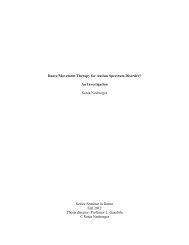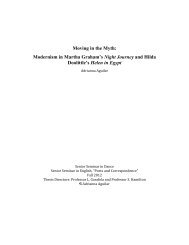Senior Thesis: 5-6 Pages - Dance - Barnard College
Senior Thesis: 5-6 Pages - Dance - Barnard College
Senior Thesis: 5-6 Pages - Dance - Barnard College
You also want an ePaper? Increase the reach of your titles
YUMPU automatically turns print PDFs into web optimized ePapers that Google loves.
Ku Klux Klan men walked down the aisles of the theater and came on stage shouting, “Hey!<br />
Where is the nigger?” 26 Fortunately, Wilkinson’s life was not in danger because of her ability to<br />
“pass,” but the company sent her home whenever the tour hit the South.<br />
12<br />
Outside of the dance field, situations motivated by outrage to the new legal precedence<br />
placed African Americans’ lives in fear. September 1957 marked a pivotal change in America<br />
with the most famous execution of the decision in Brown. Nine black students entered the halls<br />
of a once segregated high school. Only three weeks before this, Governor Orval Faubus claimed<br />
that integration at Central High in Little Rock, Arkansas would never happen, voicing the<br />
sentiments held by many, 27 despite the fact that Brown had made segregation unconstitutional.<br />
While the decision was a significant turning point in US race relations, the transition from<br />
segregation to integration met with obstacles that prevented complete progress for blacks. As for<br />
Wilkinson, she was, gradually, encouraged by the company to leave, marking the end of her<br />
professional dancing career in America. 28<br />
Race was not the only factor shaping the opportunities for aspiring professional<br />
ballerinas. As early as the 1930s and 1940s, Joan Myers Brown cites socioeconomic<br />
disadvantages as a hindrance to equal performance and educational opportunities. Specifically,<br />
family wealth affected both the training and performance opportunities. According to Brown,<br />
“‘Well, Dr. So and So’s daughter was featured [in a school recital] where the rest of us were just<br />
not, we were just there. And I think it was about class more than color, but most of the people in<br />
that class situation were light-skinned because their fathers were caterers, doctors, lawyers.” 29<br />
Turbaugh. Zeitgeist Films/Zeitgeist Video, 2006.<br />
26 Ballets Russes.<br />
27 Kevin Chappel1, “50 Years After Little Rock,” Ebony Magazine, (October 2007), 237.<br />
28 Ballets Russes.<br />
29 Aliya Mosby, 7.
















